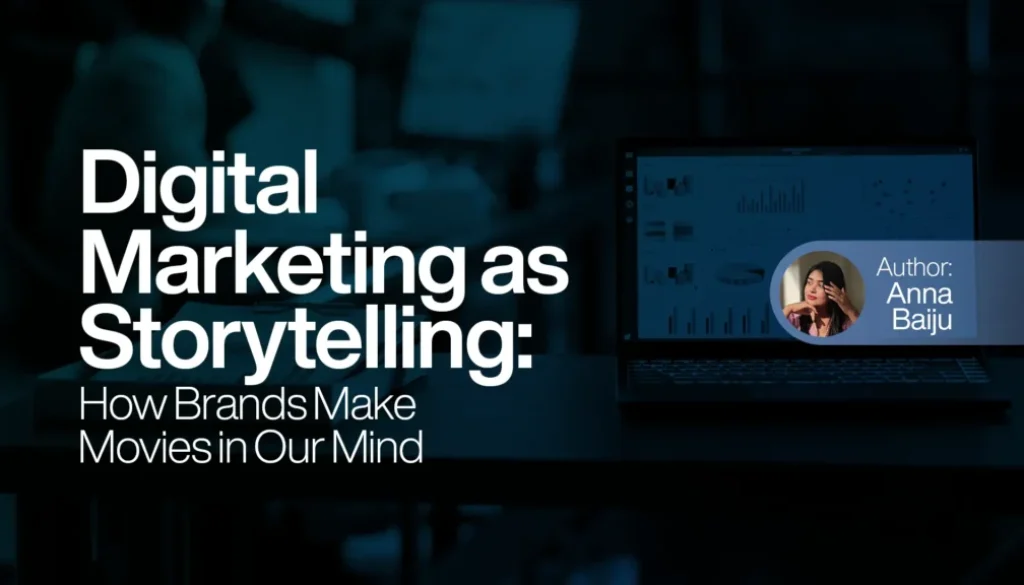Digital Marketing as Storytelling: How Brands Make Movies in Our Mind
In today’s world where attention spans are short and competition is intense, digital marketing has come a long way beyond mere promotions. It’s not merely about selling, it’s about storytelling. When executed effectively, digital marketing is a storytelling process that plays like a movie in consumers’ minds, inducing emotions, creating perceptions, and forming long-term relationships.
Let’s get into how brands are dominating this art and what exactly it means to bring digital marketing to a cinematic platform.
Table of Content
The Psychology Behind Storytelling
We are built for stories. Before written words occurred, we shared knowledge and principles through spoken stories. Now, stories still engage our hearts much more than facts and figures ever could.
Scientific research shows that storytelling activates multiple areas of the brain, not just the language centers, but also those responsible for sensations, emotions, and even motor activity. This is why a powerful story doesn’t just inform us, it immerses us. It creates mental “movies”, enabling us to feel as though we’re experiencing the events ourselves.
This is gold to digital marketers. Rather than explaining what a product is, storytelling can allow you to demonstrate to people what it’s like to use it, to need it, or even to live without it.
From Product to Protagonist: How Brands Build Stories
Marketing stories work in a format, similar to a screenplay.
- The Hero (Customer or Brand): All stories require a hero. In online storytelling, the hero is usually the customer with the brand serving as the guide (imagine Yoda to Luke Skywalker). Alternatively, the brand itself is the hero, guiding users on its path.
- The Conflict (Problem): There is no good story without conflict. Brands point out a universal issue or pain that the audience faces such as being tired, being unorganized, feeling insecure, or lagging behind at work.
- The Journey (Solution): The brand’s product or service comes along as the “solution” that solves the problem, walking the user through transformation or relief.
- The Resolution (Conclusion): The customer reaches a goal or is improved by the product at the end of the story. This emotional payoff is what audience members retain.
Consider Nike. Their online campaigns seldom concentrate on shoes. They share inspiring tales of athletes breaking through barrier tales that spark motivation and emotion. Their message? “You can do it too.”
Platforms Are the New Movie Screens
In the digital marketing space, every platform serves a different purpose, such as various theaters screening segments of the same movie.
- Instagram Stories and Reels provide fast emotional hooks, such as a trailer that elicits something from you within 15 seconds.
- YouTube functions as a short film platform, best for more in-depth storytelling in commercials, interviews, or behind-the-scenes brand experiences.
- Direct mail is the director’s voiceover, warm, personal, and richer in tone.
- Websites and blogs are the “book version”, providing complete backstory, brand philosophy, and context to the story.
- Twitter/X and LinkedIn are press interviews in their own right, reiterating the voice and values of the brand in a conversational tone.
By coordinating storytelling across channels, brands establish a consistent narrative universe akin to how Marvel compiles disparate heroes and narratives across films.
Case Study: Airbnb’s Emotional Stories
Airbnb does not simply sell accommodation, it sells experiences, belonging, and togetherness.
Their “Made Possible by Hosts” campaign is a great example of digital storytelling at its best. Instead of listing benefits or promotions, their campaign depicted actual families reconnecting, kids experiencing new adventures, and travelers enjoying solitude.
These were not actors, they were actual moments, actual hosts, and actual feelings. This storytelling strategy helped Airbnb humanize its brand, especially after the COVID-19 pandemic when people craved connection more than ever. It wasn’t about rooms, it was about memory-making.
Emotional Marketing = Storytelling That Sticks
The best stories don’t just inform, they transform. That’s why emotional storytelling is at the heart of successful digital marketing.
Here’s how it works:
- Relatability: Audiences see themselves in the story. (“I’ve been there too.”)
- Empathy: They are made to feel seen, heard, and understood.
- Inspiration: They’re inspired to act, change, or participate.
Whether it’s Dove’s “Real Beauty” campaign featuring real women, or Coca-Cola’s “Share a Coke” campaign, name-personalized, these stories set something within us off.
They aren’t commercials. They’re feelings.
How to Create Story-Driven Digital Content
Here’s a step-by-step process for writing digital content that is story-like not a sales pitch:
1. Know Your Audience Inside and Out
What do their dreams, fears, routines, and challenges look like? Address those emotional hotspots directly.
2. Select a Core Message
What change do you want to demonstrate? Is it confidence, calm, success, happiness, or liberation?
3. Set Up the Conflict
Employ content to illuminate an everyday problem your audience is dealing with. Don’t be afraid to get raw or emotional. Authenticity builds trust.
4. Position Your Brand as the Solution
Your product or service isn’t the hero, your customer is. You’re here to help them win.
5. End with a Visual or Emotional Resolution
Use testimonials, user-generated content, or cinematic visuals that show the result of using your brand.
Why Storytelling is the Future of Digital Marketing
AI tech, automation, and algorithms dominate every aspect of our lives, yet human emotion can’t be automated.
When digital channels get crowded, what gets through isn’t more data, it’s connection.
Storytelling makes your brand memorable. It makes users feel something, and that makes them remember you, trust you, and select you.
And when you do it right, you’re not merely selling things, you’re scripting a movie in your customers’ mind that they’ll relive whenever they think about your company.
Final Thoughts
We don’t recall every commercial we watch. But we do recall how a brand made us feel — through moments, characters, and stories.



